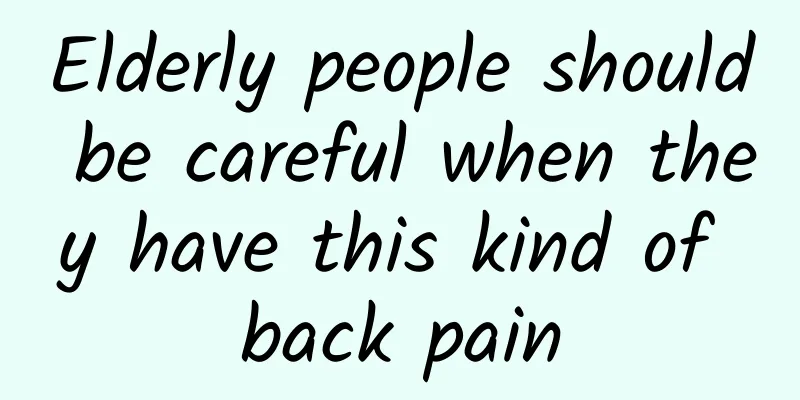Elderly people should be careful when they have this kind of back pain

|
This is the 3789th article of Da Yi Xiao Hu Real life examples On New Year's Eve, 76-year-old Grandma Zhang sat on a small stool early in the morning to wash and select vegetables for the New Year's Eve dinner. Unexpectedly, when she bent down, she felt a pain in her waist and back. With the help of her husband, she lay down on the bed. The pain in her waist seemed to be relieved. She thought that she had not fallen or bumped into anything in the past few days. It was probably because she had walked too much in the mountains before the New Year and "sprained her muscles and bones." Grandma Zhang, who did not take her back pain seriously, chose to rest at home, but after several days, the symptoms did not improve, but became more and more painful. At the insistence of her family, she went to the hospital for treatment. After a careful physical examination and X-ray examination, the doctor found that Grandma Zhang had a lumbar compression fracture. Magnetic resonance imaging confirmed that the fracture was a recent fresh fracture caused by osteoporosis in the elderly. Fortunately, after minimally invasive surgery under local anesthesia to inject bone cement into the lumbar spine, Grandma Zhang's back pain was immediately relieved, and she was discharged from the hospital in good health two days later accompanied by her family. Knowledge point: How can you have a lumbar fracture without being injured? Vertebral compression fracture is a common disease among the elderly, especially those with osteoporosis. They often suffer from spinal compression fractures due to some inconspicuous causes, such as going down stairs, bending over, getting out of bed, or even sneezing. If the pain is not severe, and if you do not pay attention to it and go to the hospital in time, the symptoms will gradually worsen, causing further compression of the vertebrae and leading to the sequelae of late back pain. The causes of vertebral compression fractures are mainly divided into two categories: traumatic and pathological. The former refers to compression fractures caused by longitudinal compression forces, such as falling or being hit by heavy objects, or extreme flexion and extension of the spine, even though there is no problem with the vertebra itself. The latter refers to compression fractures caused by certain pathological foundations in the patient, such as osteoporosis, long-term use of hormones and immunosuppressants, tumor metastasis, etc. Vertebral compression fractures are caused by slight violence, such as coughing, lifting heavy objects, bending over, etc. Vertebral compression fractures caused by osteoporosis are most common in the elderly. To be precise, they are osteoporotic vertebral compression fractures. Therefore, preventing and treating osteoporosis is the key to avoiding such fractures. Expert advice 1 Quit smoking and drinking, and drink less strong tea and carbonated drinks. Drinking a lot of strong tea and carbonated drinks can easily lead to calcium loss. The caffeine in tea can significantly inhibit the absorption of calcium in the digestive tract and promote urinary calcium excretion, causing bone calcium loss and inducing osteoporosis over time. Drinking a lot of coffee is also not good for bone health. 2 Regular bone density tests. Women around menopause and men after age 60 should regularly check bone density and bone metabolism indicators. If bone mass is decreasing rapidly, intervention can be initiated, including calcium supplementation and anti-osteoporosis drug treatment, to minimize bone loss. People with more severe osteoporosis should receive drug treatment to prevent further bone loss and promote bone mass increase. 3 Pay attention to calcium and vitamin D intake. In order to maintain normal bones, it is necessary to take in an appropriate amount of calcium. Adults are recommended to take 800 mg of calcium per day, and the elderly are recommended to take 1000-1200 mg of calcium per day. Of course, calcium supplementation alone is not enough, and you must also take in an appropriate amount of vitamin D to promote calcium absorption. 4 Exercise and sunbathe scientifically and rationally. The mechanical stimulation of bones during exercise will increase bone strength, so people who have exercise habits are less likely to suffer from osteoporosis. Vitamin D is closely related to our bone metabolism. More than 80% of the vitamin D needed by the human body is produced by ultraviolet rays irradiating the skin. People who lack sunlight will suffer from vitamin D deficiency. If there is no exogenous supplement, it will cause osteoporosis over time. Therefore, for the elderly, moderate outdoor exercise is a win-win situation for maintaining bone health. Author: Zhang Qichen, Li Juan Instructor: Dong Jian Unit: Department of Orthopedics, Zhongshan Hospital Affiliated to Fudan University Institute of Medical Science Popularization, Fudan University This article was funded by the following project: Shanghai Science and Technology Commission Science Popularization Project (No.: 20DZ2312000, 21DZ2302900) Shanghai Municipal Health Commission Outstanding Academic Leader Project (No.: GWV-10.2-XD11) |
Recommend
What are the treatments for polycystic ovary syndrome?
Polycystic ovary is a female disease that causes ...
What to do if your private parts are dark after giving birth
After giving birth, many women will have a certai...
Why does a woman have a stomachache?
Most women have cold bodies, so in daily life the...
Can women eat chocolate during menstruation?
For female friends, during menstruation, special ...
What is the reason for brown vaginal discharge after menstruation?
Period is also a kind of menstruation, just with ...
Essential knowledge for working mothers
Nowadays, many women are in the limelight and hav...
Whole grains are nutritious and give your child a bowl of staple food that doubles their health
Staple food is an indispensable food in the famil...
What does tofu dregs leucorrhea look like
The secretions of adult women have no color or sm...
Can I do moxibustion every day during the dog days? When is the best time to do moxibustion during the dog days?
Moxibustion is a very ancient Chinese medical tec...
Why cupcakes burst? What to do if the surface of cupcakes bursts?
As we all know, there are many types of cakes, an...
Female right kidney pain
In short, if some women experience kidney pain, s...
7 months pregnant stomach pain diarrhea
If you experience stomach pain and diarrhea durin...
Can I swim when I am pregnant?
I believe that many pregnant women are swimming e...
Which laser freckle removal is the best?
Everyone hopes to have fair and smooth skin, whic...
To be honest! This eye disease must be treated while it is hot!
In most people's minds, crying is a physiolog...









